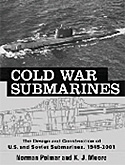 Cold War Submarines, by Norman Polmar & J. K. Moore, Naval Institute Press, 2004, $60. 00, ISBN 1-57488-594-4, 405 pp
Cold War Submarines, by Norman Polmar & J. K. Moore, Naval Institute Press, 2004, $60. 00, ISBN 1-57488-594-4, 405 pp
Messrs. Polmar and Moore are both accomplished and well-published writers on naval warfare and technology. That experience came in handy when they had the chance to interview (among others) Academician Igor Spassky and Academician Anatoly V. Kuteinikov, These two gentlemen are the chief designers and heads of the Rubin and Malachite Central Design Bureaus, respectively. The authors knew what questions to ask, and have used what they learned to correct faulty information, resolve mysteries, and produce the best single volume on postwar submarine development to date.
Starting at the end of the Second World War, Polmar and Moore cover the development of first diesel, then nuclear submarines. The chapters discuss advanced diesel submarines, closed-cycle submarine propulsion, early nuclear propulsion, US and Russian cruise missile sub programs, the development of ballistic missile submarines, then the evolution of nuclear subs as they became faster, quieter, and better armed.
Because of their sources, the authors can cover both the US and Soviet programs to the same depth. The reader can follow the design and development of each class from requirement through basic design, construction, and deployment. Many alternative designs and weapons are mentioned. For example, the original design of the Project 627 [November] SSN had a 1550mm ((yes, thatís 1. 55 meters) torpedo tube. This would allow the sub to fire a single 40-ton, 77-foot T-15 nuclear torpedo. The sub did carry two 533mm tubes (without reloads) for self-defense, but the sub was intended as a strategic strike platform. Security was tight. In July 1954, Admiral Kuznetzov, the head of the Soviet navy, was finally shown the plans. This was the first time he had seen the design, and he'd also never heard of the T-15 torpedo. Kuznetzov rejected it immediately. In the end, the Project 627 was completed with standard torpedo tube armament.
There are some things missing. The book focuses on submarine hulls and propulsion, and while it spends some time on weapons, it does not cover them as thoroughly as they might, for example linking the appearance of some torpedo types to classes. Also, there is little discussion of sonar. These are minor flaws, though. Itís definitely worth picking up.
BT
Back to The Naval Sitrep # 26 Table of Contents
Back to Naval Sitrep List of Issues
Back to MagWeb Master Magazine List
& copy Copyright 2004 by Larry Bond and Clash of Arms.
This article appears in MagWeb.com (Magazine Web) on the Internet World Wide Web.
Other military history and related articles are available at http://www.magweb.com